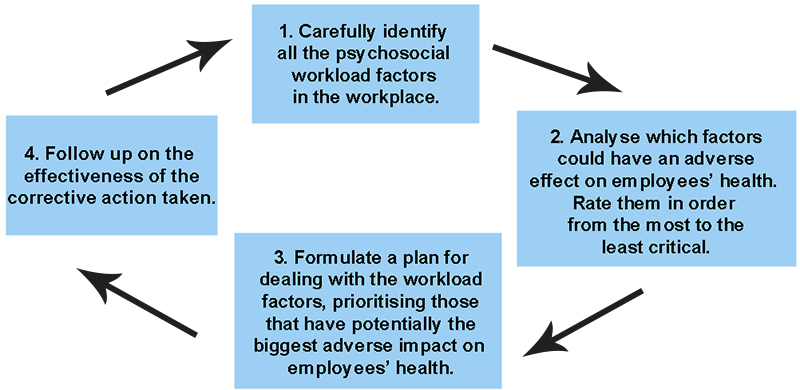

Working conditions
Psychosocial workload
Psychosocial workload factors refer to factors relating to the nature of work and work arrangements as well as the social dynamics of the work community that can have a harmful impact on employees’ health. Psychosocial workload can become an issue if the aforementioned factors are off balance, poorly managed or dysfunctional.
General information on topic
The right workload promotes employees’ health and work ability. However, harmful psychosocial workloads can occur in all kinds of workplaces and have an adverse effect on any kind of employee.
Prevention of harmful workloads
Employers must strive to prevent harmful workloads rather than just managing their consequences. Employers have a duty to be proactive in eliminating or minimising the risk and harmful effect of work-related strain.
Psychosocial workload factors can be managed just as systematically as factors relating to the physical work environment. Risk assessment and analysis are among the most important tools. Without a comprehensive risk assessment, it can be impossible to identify the need for preventive action.
Risk assessment process

- Identify the psychosocial workload factors present in the workplace.
- Analyse their impact on health (risk) and rate them from the most to the least critical.
- Take action to reduce the associated risks.
- Follow up on the impact of the action taken.
Managing work-related strain with the help of occupational health care
Employers who do not have enough knowledge to identify and analyse psychosocial workload factors should consult external experts who have the necessary competence, such as their occupational health care provider. Occupational health care professionals know the causes of work-related strain and have access to employees’ medical records. Efficient cooperation with occupational health care professionals enables employers to address any psychosocial workload factors that could pose a risk to their employees’ health before they become an issue.
Occupational health care professionals’ understanding of the issues is based on workplace surveys. It is the employer’s duty to ensure that their occupational health care provider has identified and analysed all the psychosocial workload factors present in the workplace. This means that the employer must provide their occupational health care provider with all the information they need on the nature of the work and work arrangements, their employees, circumstances in the workplace and any changes in the same. The occupational health care provider’s workplace survey report must set out conclusions on any workload factors that can affect employees’ health and suggestions on how to address them.
Instructions for employee
What to do if you are feeling overwhelmed by your work?
Tell your employer that your workload is too high. Do not wait for the problem to fix itself. Let your employer, i.e. usually your line manager, know about it as soon as possible.
Explain to them that you are suffering from work-related strain and what it is about your job that you are finding particularly overwhelming. Ask your employer to do something to change the situation. Your line manager will then discuss the underlying issues with you and find a solution.
Find out whether your employer has an early-intervention policy or other procedures in place for dealing with work-related strain. There is also a form for notifying your employer if you are feeling overwhelmed by your work (pdf). Ask your employer what action they intend to take. If you feel uncomfortably broaching the subject with your line manager, you can ask your occupational safety and health representative or shop steward to help. If the issue affects your entire work community, you can ask your occupational safety and health representative to talk to your employer on behalf of the entire personnel.
Expert advice from occupational health care professionals
It can sometimes be difficult to determine whether an employee’s strain is caused by work or factors outside of work. It can also be difficult to pinpoint the elements of work that are causing the strain. Occupational health care professionals can help.
Employees can, in some circumstances, ask their employer’s occupational health care provider to carry out a work-related strain assessment on them. It is up to occupational health care professionals to determine whether an assessment is warranted. You can ask to be assessed for work-related strain if
- your physical or psychological symptoms are affecting your work ability and you believe your symptoms to be due to your work or
- you have had to seek medical help for your symptoms or take time off work due to your symptoms.
Occupational health care professionals can give recommendations on the basis of the assessment on how to reduce your workload. Your employer’s occupational health care provider has a duty to consult with your employer before recommending and implementing solutions.
Role of the occupational safety and health authority
If your employer ignores your reports of work-related strain and does not lower your workload, you can call the occupational safety and health administration’s national telephone service for advice and information.
Occupational safety and health authorities provide instructions and advice and can order employers (after being notified of an employee’s workload compromising their health) to take action to analyse the causes of the strain and prevent the associated risks.
Instructions for employer
Employers have a duty to know the psychosocial workload factors present in their employees’ work environment and to take action if they are posing a risk to their employees’ health. Employers must also continuously monitor the health of their employees and intervene if an individual employee’s workload is jeopardising their health.
Employers’ duty to identify harmful workloads before they becomes an issue
The management have a duty to continuously monitor employees’ health and the safety of the work community’s practices. The aim is to identify harmful workloads before they become an issue. Early intervention makes it easier to find solutions to the problem. Examples of good ways to monitor employees’ workloads include performance reviews, human resources surveys and ensuring safety on a practical level each day.
Employers are responsible for training their managers to identify work-related strain at an early stage. In practice, this means teaching managers to spot the warning signs of work-related strain, which include, among others,
- an increase in health-related issues and sickness absences
- longer and longer working days
- a drop in an employee’s performance or the quality of their work
- changes in an employee’s behaviour
- withdrawal from social interactions
- an increase in conflicts within the work community, and
- an increase in safety-related incidents.
It is recommended that employers introduce an early-intervention model and instruct their managers to look out for certain warning signs and react to them in accordance with a set procedure.
Addressing work-related strain
Issues relating to work-related strain can be spotted by a manager independently or brought to their attention by individual employees. Managers can also be notified of employees whose workloads are damaging their health by occupational health care professionals or occupational safety and health representatives.
The issue should first be addressed privately between the affected employee and their line manager. If the employer has an early-intervention policy or other procedures in place for dealing with work-related strain, those should be followed. If expert advice is needed to determine whether an employee is suffering from work-related strain, the most natural source of advice is the employer’s occupational health care provider.
If an employee’s workload is found to be straining them to a point where their health is at risk, it is the employer’s responsibility to
- find out the causes of the employee’s work-related strain
- consult occupational health care professionals, if necessary, to analyse the reasons for the issue (e.g. if it is unclear whether the employee’s strain is due to their work or factors outside of work), and
- take any steps available to reduce the employee’s workload.
Dealing with prolonged sickness absences
If an employee remains unfit for work for a long time, it is the employer’s duty to consult with their occupational health care provider. The aim is to get the employee the support that they need as soon as possible and to make their sick leave as short as possible.
Employers must notify their occupational health care provider of all sickness absences that continue for more than 30 days. Occupational health care professionals will then begin to look into ways to get the employee in question back to work and to give them access to the support that they need in cooperation with the employee and the employer.
It is the employer’s responsibility to ascertain whether special forms of support are needed in the workplace to enable the employee to return to work or continue working. These can include, for example, different work arrangements or working hours or changes to the employee’s job description.
Sickness allowance is only paid to employees who can produce a medical report drawn up by an occupational health physician by the time they have received a sickness allowance from the Social Insurance Institution of Finland for a period of 90 working days during a two-year period. It is the occupational health physician’s responsibility to evaluate the employee’s remaining work ability and their possibilities of returning to work.
More information is available on the website of the Social Insurance Institution of Finland (in Finnish).
Legislation
Occupational Safety and Health Act (738/2002)
- Section 8 – Employers’ general duty to exercise care
- Section 10 – Analysis and assessment of the risks at work
- Section 13 – Work design
- Section 25 – Avoiding and reducing workloads
Occupational Health Care Act (1383/2001)
- Section 10a – Reporting absences due to illness
- Section 12 – Content of occupational health care
- Section 15 – Duty of employer to provide information
- Section 17 – Duty of occupational health care service provider to provide advice and information

